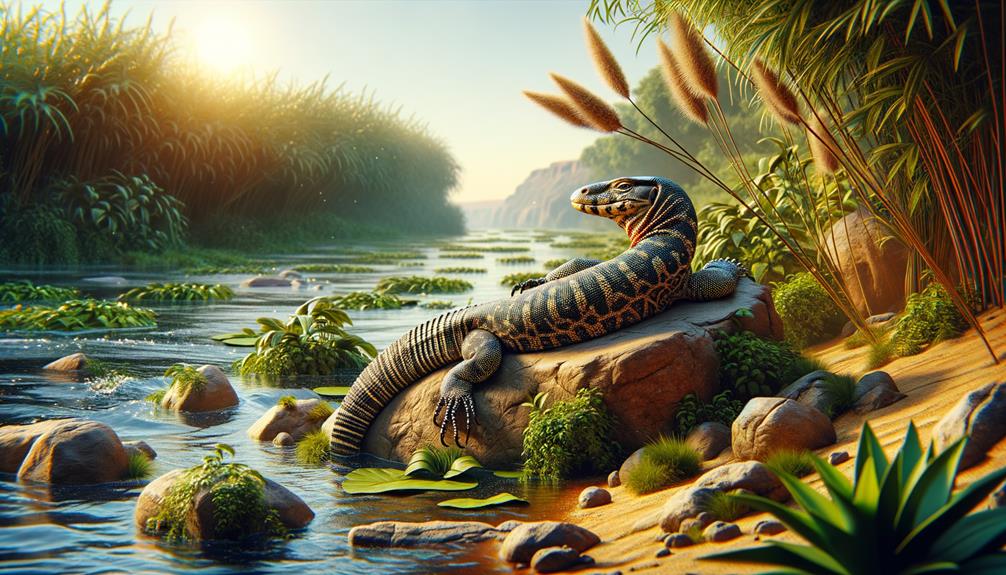The Nile monitors along the Nile River's banks are impressive creatures, often seeming to rule their watery domain. These reptiles, with their streamlined, muscular bodies and strong tails, are well-suited to life in and around water. Watching one smoothly swim through the river, eyes alert for potential prey, is a captivating sight. But these fascinating animals are more than just skilled swimmers. Their role in the ecosystem is complex, contributing to the intricate balance of life in Africa's most famous river. How do these large lizards fit into the broader picture of the Nile's biodiversity? What impact do they have on other species in the area? These questions point to the deeper significance of Nile monitors in their habitat.
Physical Characteristics
Nile monitors stand out as Africa's longest lizards, reaching lengths of up to 220cm. Their robust build and strong jaws make quite an impression. These reptiles excel at swimming, climbing, and running, thanks to their muscular bodies and powerful legs. Their sharp claws are key for grabbing prey and scaling trees, while their sturdy jaws can crack even the toughest shells.
The color patterns of Nile monitors are striking. Young ones often sport bright olive green bodies with yellow or cream stripes, which darken to black as they grow older. These patterns help them blend in and also show their age and dominance in their habitat.
Adult Nile monitors vary greatly in size, weighing anywhere from 0.8kg to 20kg. This range reflects their diverse diet, which includes insects, fish, birds, and small mammals. Their adaptability and physical strength are impressive, showing the raw power of nature in Africa's wild spaces. Watching these lizards in action offers a glimpse into the untamed beauty of the natural world.
Habitat and Distribution

Nile monitors showcase remarkable adaptability across Sub-Saharan Africa. From Senegal to Somalia, these lizards thrive in diverse environments including swamps, woodlands, and savannas. They're not just lowland dwellers; some populations live at elevations up to 2,000 meters. Typically found near water, these reptiles excel at swimming and climbing, and are active during daylight hours.
Their ability to adapt to various habitats demonstrates their survival skills. While avoiding deserts, they flourish in most other environments, showcasing their resourcefulness.
A glimpse into their varied habitats and distribution:
| Habitat Type | Location Examples |
|---|---|
| Swamps | Nile Delta, Okavango Delta |
| Woodlands | Serengeti, Miombo Woodlands |
| Savannas | Maasai Mara, Kruger Park |
| Near Water Sources | Along the Nile River |
| High Altitudes | Ethiopian Highlands |
The wide-ranging presence of Nile monitors across Sub-Saharan Africa speaks to nature's versatility. Their existence in various ecosystems highlights the richness of their habitats. Whether swimming in swamps or scaling trees in woodlands, these lizards exemplify adaptation and resilience in the wild.
Diet and Hunting

Nile monitors are skilled hunters with sharp senses and nimble bodies. They eat a wide range of food, from fish and bugs to small furry animals and birds. These adaptable eaters can find meals in many different places, making them very successful predators both in fresh and salt water.
Their menu is quite varied:
- They catch fish and shellfish in rivers and oceans, showing how well they adjust to different environments.
- Quick-moving insects and frogs are easy snacks for these agile lizards.
- They're also good at catching small mammals and birds on land.
- Being opportunists, they'll happily munch on other reptiles or even animals that are already dead.
This wide-ranging diet helps Nile monitors thrive in various habitats. They're not picky eaters, which is a big advantage in the wild. Whether hunting in water or on land, these lizards are always on the lookout for their next meal.
Behavior and Activity

Nile monitors are fascinating creatures, active during daylight hours and remarkably skilled at both climbing and swimming. They flourish in various environments, always sticking close to water – whether it's swamps, woodlands, or savannas. Watching these reptiles navigate their surroundings is captivating; you might spot them sunning themselves on tree branches or gliding through water with ease.
These lizards make the most of their daytime hours, hunting and exploring their territory. Their impressive climbing and swimming abilities allow them to move swiftly between trees and water, showcasing their agility. As night falls, they seek shelter in burrows or thick vegetation, emerging again at dawn.
The hunting behavior of Nile monitors is particularly interesting, driven by their hearty appetites. They're not picky eaters, preying on a wide range of animals, which makes them formidable predators in their ecosystem. Their adaptability to different environments and relentless pursuit of food underscore their survival prowess. Observing these reptiles in action offers a glimpse into nature's ingenuity, as they blend strength, agility, and cunning in their daily routines. The way they thrive in their natural habitat is truly remarkable.
Conservation Status

Florida's wildlife is under threat from Nile monitor lizards, which have become a major problem since they were first spotted in the state. These aggressive hunters are putting many local animals at risk, including burrowing owls, sea turtles, and even crocodiles.
In 2021, Florida took action by adding Nile monitors to its list of banned species. This means that, with a landowner's okay, these lizards can be killed humanely on private property, as long as it's done within animal welfare guidelines.
Nile monitors, originally from Africa, are now wreaking havoc in Florida. They're not just a problem for wildlife – they've been known to go after pets in residential areas too. The state is working hard to control their numbers and protect native species that are at risk.
These lizards are found throughout the Nile River delta and parts of sub-Saharan Africa. In Florida, they've spread widely, causing serious ecological damage. Officials are trying to limit their impact and safeguard the state's unique ecosystems.
Frequently Asked Questions
Where Do Nile Monitors Live?
Nile monitors call Sub-Saharan Africa home, thriving in wet and dry environments alike. You'll spot these impressive reptiles in swamps, forests, and grasslands across the region. They're particularly fond of watery habitats, where their swimming and climbing skills shine. During the day, they often bask on tree branches hanging over water, soaking up the sun. As night falls, they retreat to their hiding spots for safety. Watching these agile creatures in their natural habitat is a fascinating experience, offering a glimpse into the diverse wildlife of Africa.
Are Nile Monitors Venomous?
Contrary to popular belief, Nile monitors don't pack a venomous punch. These large lizards rely on brute force, razor-sharp teeth, and muscular jaws to overpower their prey. While their bite can lead to nasty infections due to the bacteria lurking in their mouths, it's not the same as the venom produced by some of their reptilian cousins. So, if you ever cross paths with one of these impressive creatures, remember: they're all muscle, no poison.
How Did Nile Monitors Get to Florida?
The Nile monitor's arrival in Florida traces back to the exotic pet industry. Imported from West Africa, these large lizards have been breeding in the wild since the early 1990s. Today, they're considered a major problem species, with a notable concentration in Lee County. The reptiles' spread highlights the unintended consequences of the pet trade on local ecosystems. Wildlife experts are now grappling with how to manage these adaptable predators, which pose a threat to native wildlife and can even be a nuisance to residents. The situation underscores the need for stricter regulations on exotic animal imports and responsible pet ownership to prevent similar ecological disruptions in the future.
What Are Some Fun Facts About the Nile Monitor?
Nile monitors are truly remarkable creatures. These massive lizards can reach lengths of up to 220cm and tip the scales anywhere from 0.8 to 20kg. They're not just impressive in size, though – these reptiles are incredibly adaptable, excelling as swimmers, climbers, and runners. With their strong jaws, razor-sharp claws, and bold nature, Nile monitors are formidable hunters. However, their challenging temperament makes them a handful as pets, better suited for experienced keepers or left in their natural habitats.



